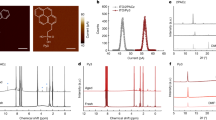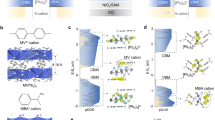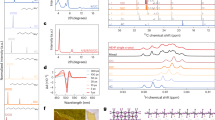Abstract
Perovskite solar cells represent a promising class of photovoltaics that have achieved exceptional levels of performance within a short time. Such high efficiencies often depend on the use of molecule-based selective contacts that form highly ordered molecular assemblies. Although this high degree of ordering usually benefits charge-carrier transport, it is disrupted by structure deformation and phase transformation when subjected to external stresses, which limits the long-term operational stability of perovskite solar cells. Here we demonstrate a molecular contact with an orthogonal π-skeleton that shows better resilience to external stimuli than commonly used conjugated cores. This molecular design yields a disordered, amorphous structure that is not only highly stable but also demonstrates exceptional charge selectivity and transport capability. The perovskite solar cells fabricated with this orthogonal π-skeleton molecule exhibited enhanced long-term durability in accelerated-ageing tests. This orthogonal π-skeleton functionality opens new opportunities in molecular design for applications in organic electronics.

This is a preview of subscription content, access via your institution
Access options
Access Nature and 54 other Nature Portfolio journals
Get Nature+, our best-value online-access subscription
27,99 € / 30 days
cancel any time
Subscribe to this journal
Receive 12 print issues and online access
269,00 € per year
only 22,42 € per issue
Buy this article
- Purchase on SpringerLink
- Instant access to full article PDF
Prices may be subject to local taxes which are calculated during checkout




Similar content being viewed by others
Data availability
All data are available in the main article and the Supplementary Information, or on request from the corresponding authors. Source data are provided with this paper.
References
Jiang, Q. & Zhu, K. Rapid advances enabling high-performance inverted perovskite solar cells. Nat. Rev. Mater. 9, 399–419 (2024).
Zhang, S. et al. Minimizing buried interfacial defects for efficient inverted perovskite solar cells. Science 380, 404–409 (2023).
Zhu, J. et al. A donor–acceptor-type hole-selective contact reducing non-radiative recombination losses in both subcells towards efficient all-perovskite tandems. Nat. Energy 8, 714–724 (2023).
Yu, S. et al. Homogenized NiOx nanoparticles for improved hole transport in inverted perovskite solar cells. Science 382, 1399–1404 (2023).
Jiang, Q. et al. Towards linking lab and field lifetimes of perovskite solar cells. Nature 623, 313–318 (2023).
Zhang, H. et al. Formamidinium lead iodide‐based inverted perovskite solar cells with efficiency over 25% enabled by an amphiphilic molecular hole‐transporter. Angew. Chem. Int. Ed. 63, e202401260 (2024).
Li, L. et al. Flexible all-perovskite tandem solar cells approaching 25% efficiency with molecule-bridged hole-selective contact. Nat. Energy 7, 708–717 (2022).
He, R. et al. All-perovskite tandem 1 cm2 cells with improved interface quality. Nature 618, 80–86 (2023).
Wu, T. et al. Graphene-like conjugated molecule as hole-selective contact for operationally stable inverted perovskite solar cells and modules. Adv. Mater. 35, 2300169 (2023).
Zhang, S. et al. Conjugated self-assembled monolayer as stable hole-selective contact for inverted perovskite solar cells. ACS Materials Lett. 4, 1976–1983 (2022).
Ge, Q. Q. et al. A two-dimensional hole-transporting material for high-performance perovskite solar cells with 20% average efficiency. Angew. Chem. Int. Ed. 57, 10959–10965 (2018).
Guo, H. et al. A coplanar π‐extended quinoxaline based hole‐transporting material enabling over 21% efficiency for dopant‐free perovskite solar cells. Angew. Chem. Int. Ed. 60, 2674–2679 (2020).
Gao, Y. et al. Highly stable lead-free perovskite field-effect transistors incorporating linear π-conjugated organic ligands. J. Am. Chem. Soc. 141, 15577–15585 (2019).
Dou, L., Liu, Y., Hong, Z., Li, G. & Yang, Y. Low-bandgap near-IR conjugated polymers/molecules for organic electronics. Chem. Rev. 115, 12633–12665 (2015).
Li, G., Chang, W.-H. & Yang, Y. Low-bandgap conjugated polymers enabling solution-processable tandem solar cells. Nat. Rev. Mater. 2, 17043 (2017).
Sun, G. et al. High performance polymerized small molecule acceptor by synergistic optimization on π-bridge linker and side chain. Nat. Commun. 13, 5267 (2022).
Meng, D. et al. Configurable organic charge carriers toward stable perovskite photovoltaics. Chem. Rev. 122, 14954–14986 (2022).
Ma, K. et al. Multifunctional conjugated ligand engineering for stable and efficient perovskite solar cells. Adv. Mater. 33, 2100791 (2021).
Ma, R. et al. Unveiling the morphological and physical mechanism of burn‐in loss alleviation by ternary matrix toward stable and efficient all‐polymer solar cells. Adv. Mater. 35, 2212275 (2023).
Hu, H. et al. Synergistic strategy of rigid-bridge and flexible-bridge achieving high-performance and mechanical robustness all-polymer solar cells. Chem. Eng. J. 491, 152009 (2024).
Yi, J., Zhang, G., Yu, H. & Yan, H. Advantages, challenges and molecular design of different material types used in organic solar cells. Nat. Rev. Mater. 9, 46–62 (2023).
Fu, J. et al. Rational molecular and device design enables organic solar cells approaching 20% efficiency. Nat. Commun. 15, 1830 (2024).
Wang, H. F., Velarde, L., Gan, W. & Fu, L. Quantitative sum-frequency generation vibrational spectroscopy of molecular surfaces and interfaces: lineshape, polarization, and orientation. Annu. Rev. Phys. Chem. 66, 189–216 (2015).
Krogmeier, B., Staub, F., Grabowski, D., Rau, U. & Kirchartz, T. Quantitative analysis of the transient photoluminescence of CH3NH3PbI3/PC61BM heterojunctions by numerical simulations. Sustain. Energy Fuels 2, 1027–1034 (2018).
Krückemeier, L., Krogmeier, B., Liu, Z., Rau, U. & Kirchartz, T. Understanding transient photoluminescence in halide perovskite layer stacks and solar cells. Adv. Energy Mater. 11, 2003489 (2021).
Acknowledgements
We thank L. Liu, Y. Nie, C. Mu, X. Miao, T. Zhou, X. Lu, Y. Chen, Z. Chen, Y. Cheng, D. Gu, C. Wang and M. Zhou for assistance with the characterizations. J. Xue acknowledges a grant from the National Natural Science Foundation of China (grant number 62274146). J. Xue and R.W. acknowledge grants (grant numbers LR24F040001, LD22E020002 and LD24E020001) from the Natural Science Foundation of Zhejiang Province of China. J. Xue acknowledges a grant of financial support from the Shanxi-Zheda Institute of Advanced Materials and Chemical Engineering (2021SZ-FR006), and support from the Foundation for Innovative Research Groups of the National Natural Science Foundation of China (grant number 61721005). R.W. acknowledges a grant from the National Natural Science Foundation of China (grant number 62474143) and support from the Key R&D Program of Zhejiang (2024SSYS0061) This work was also supported by the National Natural Science Foundation of China (grant number 62204209), the Fundamental Research Funds for the Central Universities (226-2022-00200), the Zhejiang Key Laboratory of Low-Carbon Intelligent Synthetic Biology (2024ZY01025) and Muyuan Laboratory (programme ID 14136022401). H.-F.W. acknowledges a National Key Instrumentation Development grant from the National Natural Science Foundation of China (grant number 21727802).
Author information
Authors and Affiliations
Contributions
J. Xue, R.W., J.Z. and Y.L. conceived the idea. J.Z. synthesized all the molecules. J.Z., R.L. and L.T. fabricated the perovskite films and devices. J.Z. and Y.L. performed the data analysis under the supervision of R.W. and J. Xue. K.Z., J. Shen, D.J., Z.P., L.Y., Q.L., S.Z., L.J., S.C., S.W., Y.T., J. Xu, X.Z., P.S., X.W., W.F., P.S., X.S. and J. Sun assisted with the characterizations and device fabrication. L.Z. and L.-Z.C. conducted the SFG-VS experiment with J.Z. under the supervision of H.-F.W. G.W., W.S. and T.D. performed the theoretical calculations. D.Y. provided insightful discussions. J. Xue wrote the manuscript. All the authors discussed the results and commented on the manuscript.
Corresponding authors
Ethics declarations
Competing interests
The authors declare no competing interests.
Peer review
Peer review information
Nature Chemistry thanks Sang Il Seok and the other, anonymous, reviewer(s) for their contribution to the peer review of this work.
Additional information
Publisher’s note Springer Nature remains neutral with regard to jurisdictional claims in published maps and institutional affiliations.
Supplementary information
Supplementary Information
Supplementary Texts 1–5 and Figs. 1–100.
Source data
Source Data Fig. 1
Statistical source data.
Source Data Fig. 2
Statistical source data.
Source Data Fig. 3
Statistical source data.
Source Data Fig. 4
Statistical source data.
Rights and permissions
Springer Nature or its licensor (e.g. a society or other partner) holds exclusive rights to this article under a publishing agreement with the author(s) or other rightsholder(s); author self-archiving of the accepted manuscript version of this article is solely governed by the terms of such publishing agreement and applicable law.
About this article
Cite this article
Zhou, J., Luo, Y., Li, R. et al. Molecular contacts with an orthogonal π-skeleton induce amorphization to enhance perovskite solar cell performance. Nat. Chem. 17, 564–570 (2025). https://doi.org/10.1038/s41557-025-01732-z
Received:
Accepted:
Published:
Issue Date:
DOI: https://doi.org/10.1038/s41557-025-01732-z
This article is cited by
-
Stabilizing molecular contacts via amorphous structures
Science China Chemistry (2025)



